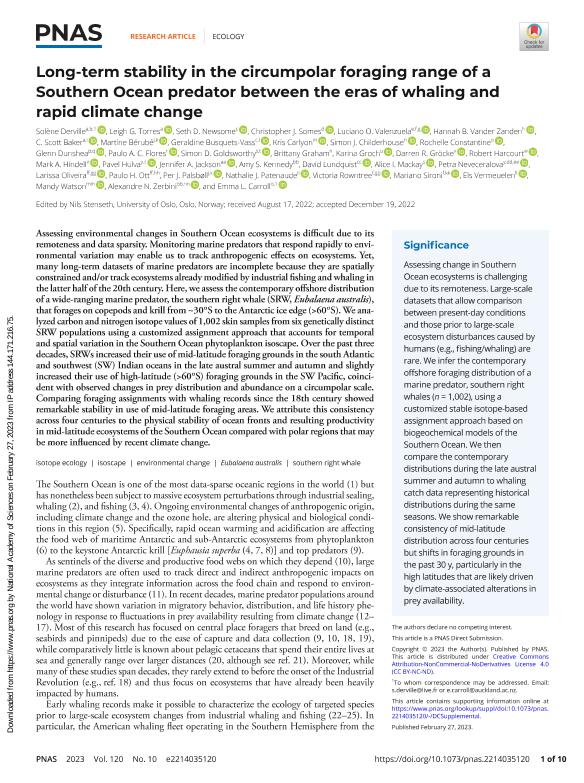Artículo
Long-term stability in the circumpolar foraging range of a Southern Ocean predator between the eras of whaling and rapid climate change
Derville, Solène; Torres, Leigh G.; Newsome, Seth Darnaby; Somes, Christopher J.; Valenzuela, Luciano Oscar ; Vander Zanden, Hannah B.; Baker, C. Scott; Bérubé, Martine; Busquets-Vass, Geraldine; Carlyon, Kris; Childerhouse, Simon J.; Constantine, Rochelle; Dunshea, Glenn; Flores, Paulo A. C.; Goldsworthy, Simon D.; Graham, Brittany; Groch, Karina; Gröcke, Darren R.; Harcourt, Robert; Hindell, Mark A.; Hulva, Pavel; Jackson, Jennifer A.; Kennedy, Amy S.; Lundquist, David; Mackay, Alice I.; Neveceralova, Petra; Oliveira, Larissa; Ott, Paulo H.; Palsbøll, Per J.; Patenaude, Nathalie J.; Rowntree, Victoria; Sironi, Mariano; Vermeuelen, Els; Watson, Mandy; Zerbini, Alexandre; Carroll, Emma L.
; Vander Zanden, Hannah B.; Baker, C. Scott; Bérubé, Martine; Busquets-Vass, Geraldine; Carlyon, Kris; Childerhouse, Simon J.; Constantine, Rochelle; Dunshea, Glenn; Flores, Paulo A. C.; Goldsworthy, Simon D.; Graham, Brittany; Groch, Karina; Gröcke, Darren R.; Harcourt, Robert; Hindell, Mark A.; Hulva, Pavel; Jackson, Jennifer A.; Kennedy, Amy S.; Lundquist, David; Mackay, Alice I.; Neveceralova, Petra; Oliveira, Larissa; Ott, Paulo H.; Palsbøll, Per J.; Patenaude, Nathalie J.; Rowntree, Victoria; Sironi, Mariano; Vermeuelen, Els; Watson, Mandy; Zerbini, Alexandre; Carroll, Emma L.
 ; Vander Zanden, Hannah B.; Baker, C. Scott; Bérubé, Martine; Busquets-Vass, Geraldine; Carlyon, Kris; Childerhouse, Simon J.; Constantine, Rochelle; Dunshea, Glenn; Flores, Paulo A. C.; Goldsworthy, Simon D.; Graham, Brittany; Groch, Karina; Gröcke, Darren R.; Harcourt, Robert; Hindell, Mark A.; Hulva, Pavel; Jackson, Jennifer A.; Kennedy, Amy S.; Lundquist, David; Mackay, Alice I.; Neveceralova, Petra; Oliveira, Larissa; Ott, Paulo H.; Palsbøll, Per J.; Patenaude, Nathalie J.; Rowntree, Victoria; Sironi, Mariano; Vermeuelen, Els; Watson, Mandy; Zerbini, Alexandre; Carroll, Emma L.
; Vander Zanden, Hannah B.; Baker, C. Scott; Bérubé, Martine; Busquets-Vass, Geraldine; Carlyon, Kris; Childerhouse, Simon J.; Constantine, Rochelle; Dunshea, Glenn; Flores, Paulo A. C.; Goldsworthy, Simon D.; Graham, Brittany; Groch, Karina; Gröcke, Darren R.; Harcourt, Robert; Hindell, Mark A.; Hulva, Pavel; Jackson, Jennifer A.; Kennedy, Amy S.; Lundquist, David; Mackay, Alice I.; Neveceralova, Petra; Oliveira, Larissa; Ott, Paulo H.; Palsbøll, Per J.; Patenaude, Nathalie J.; Rowntree, Victoria; Sironi, Mariano; Vermeuelen, Els; Watson, Mandy; Zerbini, Alexandre; Carroll, Emma L.
Fecha de publicación:
03/2023
Editorial:
National Academy of Sciences
Revista:
Proceedings of the National Academy of Sciences of The United States of America
ISSN:
0027-8424
Idioma:
Inglés
Tipo de recurso:
Artículo publicado
Clasificación temática:
Resumen
Assessing environmental changes in Southern Ocean ecosystems is difficult due to its remoteness and data sparsity. Monitoring marine predators that respond rapidly to environmental variation may enable us to track anthropogenic effects on ecosystems. Yet, many long-term datasets of marine predators are incomplete because they are spatially constrained and/or track ecosystems already modified by industrial fishing and whaling in the latter half of the 20th century. Here, we assess the contemporary offshore distribution of a wide-ranging marine predator, the southern right whale (SRW, Eubalaena australis), that forages on copepods and krill from ~30°S to the Antarctic ice edge (>60°S). We analyzed carbon and nitrogen isotope values of 1,002 skin samples from six genetically distinct SRW populations using a customized assignment approach that accounts for temporal and spatial variation in the Southern Ocean phytoplankton isoscape. Over the past three decades, SRWs increased their use of mid-latitude foraging grounds in the south Atlantic and southwest (SW) Indian oceans in the late austral summer and autumn and slightly increased their use of high-latitude (>60°S) foraging grounds in the SW Pacific, coincident with observed changes in prey distribution and abundance on a circumpolar scale. Comparing foraging assignments with whaling records since the 18th century showed remarkable stability in use of mid-latitude foraging areas. We attribute this consistency across four centuries to the physical stability of ocean fronts and resulting productivity in mid-latitude ecosystems of the Southern Ocean compared with polar regions that may be more influenced by recent climate change.
Archivos asociados
Licencia
Identificadores
Colecciones
Articulos(CCT - TANDIL)
Articulos de CTRO CIENTIFICO TECNOLOGICO CONICET - TANDIL
Articulos de CTRO CIENTIFICO TECNOLOGICO CONICET - TANDIL
Citación
Derville, Solène; Torres, Leigh G.; Newsome, Seth Darnaby; Somes, Christopher J.; Valenzuela, Luciano Oscar; et al.; Long-term stability in the circumpolar foraging range of a Southern Ocean predator between the eras of whaling and rapid climate change; National Academy of Sciences; Proceedings of the National Academy of Sciences of The United States of America; 120; 10; 3-2023; 1-10
Compartir
Altmétricas



